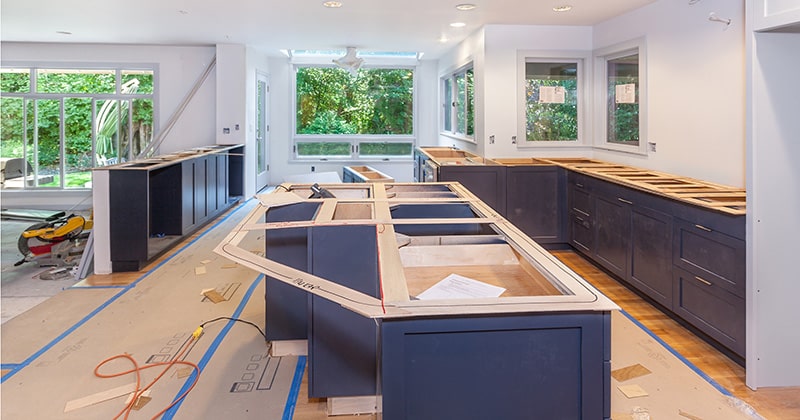How much effort do you put into remodeling project management?
Project management is the crucial basis of any remodeling job. How you manage projects can determine profitability, customer satisfaction, and overall business success. It can easily make or break your remodeling business.
So, what’s the best way to manage remodeling projects?
This article shares valuable insights into managing remodeling jobs. Read on to learn the fundamentals, best practices, and challenges of remodeling project management.
FROM ONE OF OUR PARTNERS: How to Start a Home Renovation Business
Understanding the Basics of Remodeling Project Management
Project management means planning and organizing resources to achieve set goals. Remodeling contract resources generally include labor, materials, and time. The goals are:
- Deliver within budget.
- Meet deadlines.
- Do a high-quality job.
- Meet safety, industrial, and legal standards.
- Satisfy the customer.
- Turn a profit.
Project management also involves managing risks. A project manager foresees any risks to the project and takes actions to avoid them.
Project management draws up the road map for completing a particular remodeling job. It tells you what’s needed (and how to get it) to work effectively to meet a project’s goals.
And it’s true what they say: “Failing to plan is planning to fail.” One study found that only 30% of contractors finish their projects on time and within budget. That all comes down to poor project management.
Here’s what project management for remodelers typically entails:
- Setting the project’s goals and scope
- Organizing and overseeing remodeling crews
- Allocating money, materials, equipment, and labor to various tasks
- Quantifying and ordering materials
- Taking care of logistics (transport, storage, waste disposal, etc.)
- Documenting the project’s progress
- Setting the pace
- Communicating with everyone involved
- Quality control
FROM ONE OF OUR PARTNERS: 7 Steps for Creating a Remodeling Business Plan

The 5 Key Components of Successful Remodeling Project Management
Remodeling projects can be complex, with many moving parts. So, it makes sense to break down project management into smaller phases. These are the five main phases of a project management lifecycle:
1. Project Initiation
Managing a remodeling project starts long before signing the contract. You must first evaluate each job to determine its feasibility. Ask yourself if the job is worth your company’s time and effort. Also, what are the constraints and possible challenges?
It’s crucial to involve all stakeholders in the initiation phase. Check with the crew, suppliers, and accountants about time, materials, and resource availability. Doing so will tell you if the job is doable or worth doing.
From there, set clear project goals and objectives. Make sure they’re realistic.
After everything is decided, a project initiation document (PID) is drafted. The PID highlights a project’s details. It describes scope, business value, success criteria, risks, and goals.
2. Planning Phase
The planning phase involves the following tasks:
- Logistics: Work out how to acquire everything the project requires, from labor and equipment to materials.
- Budgeting: Sum up the estimated cost of the project and budget for the available resources.
- Work allocation: Assign specific duties and responsibilities to each crew member. Ensure each is accountable for their role in the project.
- Scheduling: Estimate how long it’ll take to complete the project. More importantly, establish a work schedule showing the duration of each activity.
- Risk management: Analyze all potential risks and come up with solid solutions.
You should have a work breakdown structure (WBS) at the end of the planning phase. This is essentially a checklist that divides the project into smaller functional tasks. It makes the workflow much easier to track and control.
3. Execution
This phase kicks the project management plan into action. Things start moving. Everyone gets into their assigned roles. Deliveries start coming in. Money exchanges hands, and so on.
You have to set up everything your plan needs to work.
For instance, you’ll need communications facilities and a crew management system. You’ll want to track the progress. Luckily, MarketSharp remodeling project management software has all these capabilities and more.
4. Performance and Monitoring
This phase happens together with the execution phase as the project is underway. It generally involves making sure that everything goes as planned.
Set up a tracking system to monitor the performance of your crew, vendors, and equipment. And check whether the project is on track to reach the set milestones and goals.
Track progress while updating the project’s schedule and other parameters as needed. You may occasionally have to modify the project plan to accommodate unforeseen changes.
5. Closure
The final stage of project management marks the official completion of a remodeling job. When the job is done, do a thorough evaluation of the outcomes. Find out how well the plan faired. See what you did right and what went wrong. What you learn here can be applied to future project plans.
After that, write a project report. The report should document the entire project from start to finish, including lessons learned.
FROM ONE OF OUR PARTNERS: A Contractor’s Guide to Effective Project Management
Best Practices for Remodeling Project Management
It’s one thing to know the rules of a game, and it’s another to actually play it. The same is true for remodeling project management.
Managing a remodeling project by the book is great. But it doesn’t necessarily guarantee success. There’s a lot more you must get right.
Here are five project management best practices you should know:
1. Build a Strong Business Case for Every Project.
Contractors are sometimes so eager to take on new jobs that they overlook one crucial thing—due diligence.
For a project to be successful, it must be the right project to begin with. If you book a remodeling job that’s beneath or beyond your company, you will have trouble managing it.
Do your due diligence. Evaluate every project to see what value it brings to your business. Some remodeling jobs take more than they give and are simply not worth considering.
2. Document Everything.
Documentation is a vital managerial task. Current paperwork helps you track a project’s parameters and progress. Accurate and well-organized documents also come in handy when reviewing a completed project during closure.
3. Plan for the Worst.
Things don’t always go as planned. Sometimes, the unexpected happens. A worker gets injured. A supplier falls through. A permit gets denied, or worse. What do you do then?
You can’t possibly know every single thing that could go wrong. But it helps to have some flexibility built into your plan. In other words, anticipate and accommodate setbacks. This could mean setting aside emergency funds or lining up backup suppliers. Have a literal plan B.
4. Work with the Right People.
Managing a remodeling project is a team effort. And a team is only as strong as its weakest player.
Your suppliers, staff, team leaders, and even customers must be on the same page. After all, don’t you all want the same thing—successful project completion? In short, anyone who’s not a team player jeopardizes the entire plan.
5. Utilize Digital Project Management Tools.
Managing multiple remodeling projects at once or one big project can get complicated fast. There may be a ton of paperwork, resources, crews, and clients to track. It can be overwhelming, not to mention error-prone.
Digital systems make managing even the most complex remodeling projects much easier. MarketSharp for example, houses every project management tool you need under one roof. Every feature is designed to streamline project management, from performance tracking to workflow automation. for example, houses every project management tool you need under one roof. Every feature is designed to streamline project management, from performance tracking to workflow automation.

Common Challenges in Remodeling Project Management
Project management has its challenges. Let’s look at four common issues you might face when managing a remodeling project:
1. Scope Creep
Scope creep is the continuous or uncontrolled growth in a project’s scope. This usually occurs due to a lack of a clear definition of scope from the get-go.
Other uncontrollable factors, such as bad weather, can cause scope creep. Or, sometimes, it’s just the client trying to get some extra work done on the cheap.
The only way to handle “reasonable” scope creep is by renegotiating deadlines and costs. So, ensure all your contracts have the necessary provisions for renegotiations.
2. Cash Flow Problems
Budget constraints can cause a lot of frustration and delays. This becomes an even bigger problem if the project overruns its budget.
Solving a cash flow issue will depend on the underlying cause. And again, renegotiating is a possible way out of a sticky financial jam.
RELATED ARTICLE: How to Turn Your Business into a Profit Producing Machine
3. Safety Concerns
Construction work ranks as the most dangerous occupation in the U.S. So, any risks to the safety of construction workers and members of the public cannot be ignored. In fact, safety concerns can (and will) stop a project in its tracks.
All safety issues must be dealt with appropriately. You can either eliminate the risk or find a way to work around it.
4. Delays
Remodeling projects are highly susceptible to delays. The problem with delays is that they push deadlines and milestones forward. Delays only add to the project’s cost. Also, many clients see delays as a sign of professional incompetence.
Sorting out delays simply means eliminating the cause of the delay. Common causes of delays in remodeling projects include:
- Underperforming crew members
- Late deliveries
- Material scarcity
- Poor coordination on the job site
- Lack of strict time management
- Unexpected hiccups (injuries, blunders, bad weather, etc.)
10 Tips to Get Started with Managing Your Next Remodeling Project
Here are 10 tips summarizing what it takes to manage a remodeling project successfully:
- Pick projects that bring tangible value to your business and ones that the business can easily handle.
- Make project management a companywide responsibility.
- Prioritize time and cash flow management.
- Keep track of everything.
- Maintain clear communication with everyone involved.
- Document every step of the management process.
- Understand the risks and constraints of each project.
- Anticipate and plan for setbacks.
- Review and update your project plan as the job progresses.
- Use the right project management tools, such as MarketSharp.
FROM ONE OF OUR PARTNERS: How to Grow a Remodeling Business

